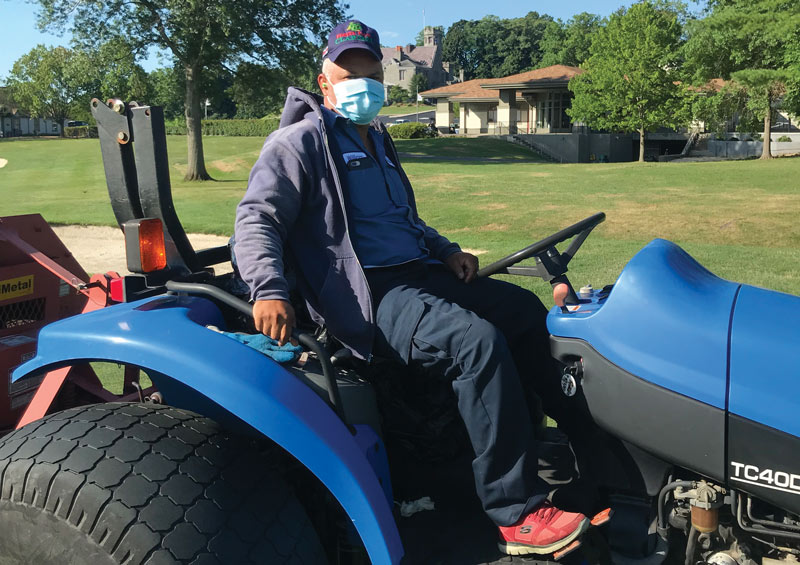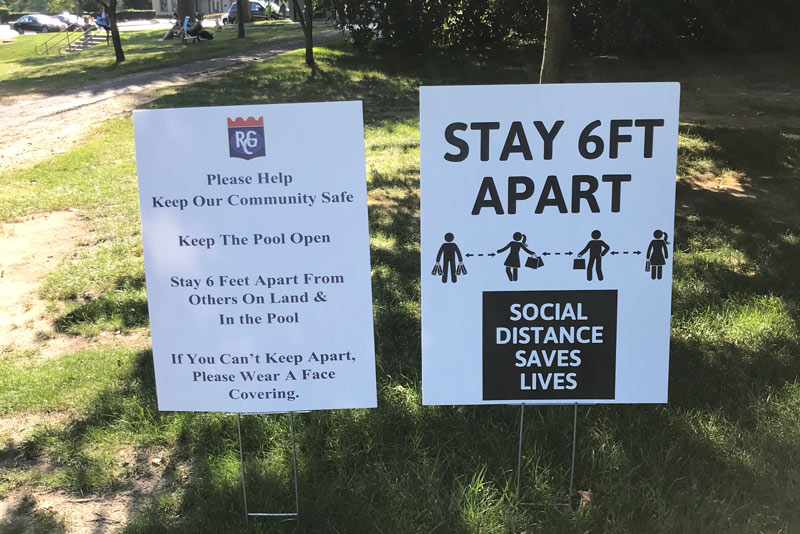
The collective challenge that was 2020 has given the golf industry invaluable wisdom for facing any trying times to come. Photo by Adobe Stock
Editor’s note: This article was originally published in the May/June/July 2020 issue of Tee to Green, a publication of the Metropolitan Golf Course Superintendents Association, Elmsford, N.Y.
“We generate fears while we sit. We overcome them by action.” — Dr. Henry C. Link
When I was an engineering officer aboard the aircraft carrier USS Independence, we had a sign prominently posted above the engineering watch station that read “What if?” It was meant to remind engineering officers to keep in mind a precise plan of action for every conceivable malfunction that could take place aboard the ship. It was essential.
“What if?” is a question successful golf course superintendents ask themselves every day. What if my pump station goes down? What if my annual bluegrass weevil application wasn’t timed correctly? What if the state enacts a drought management plan tomorrow?
But in 2020, we were hit with a question we — along with most of the rest of the world — had failed to anticipate: What if a dangerous human virus were to suddenly spread throughout the United States and threaten our well-being and livelihoods?
In early 2020, things had looked idyllic for golf here in the New York City metropolitan area, with no winter injury and the first mild March in four years. Meanwhile, on the other side of the globe, in Wuhan, China, an extremely contagious new strain of coronavirus was rapidly infecting people in the city of 11 million and slowly making its way around the world. No one knows the exact date it arrived in our area, but New York recorded its first death from the virus on March 14.
Six days later, everything changed. Gov. Andrew Cuomo signed an executive order closing all nonessential businesses and mandating that all employees of nonessential businesses stay home. New Jersey and Connecticut enacted similar executive orders. New Jersey shut down all golf course operations except for maintenance until May 2. On that date, only twosomes were permitted at 16-minute tee time intervals.
Life since March hasn’t been smooth sailing for members of the Met GCSA or for any golf course management professionals. The good news is that most of us are adapting and, in fact, learning some important lessons and even new skills. What follows are some lessons learned on how we as an industry might better prepare for future challenges.
1. Developing government relationships pays dividends
When the pandemic first hit, guidance from state governments was vague, resulting in confusion, stress and countless hours of work trying to obtain clear directives to ensure that multimillion-dollar golf courses were not abandoned. A new relationship had to be forged with New York’s Empire State Development Corp., as it was the entity that determined and published guidance on essential businesses and activities.
Never had the relationships already developed with elected officials and government agencies proved so vital. Many of our previous contacts helped connect us with the right people in this organization, enabling us to smooth the way for open communication and clarification on numerous issues. Industry organizations and individuals pulled together, sharing information with government officials and doing what was needed to ensure the viability of the golf course maintenance industry and, ultimately, the game of golf itself.
The result? Golf course maintenance workers were designated as essential.
Of course, those government relationships didn’t develop overnight. They were nurtured through many years of working with state legislative bodies to deepen their understanding of our industry and its benefits to the environment and the economy. Attending events such as our New York State Turfgrass Advocacy Day in Albany, smaller but more frequent state advocacy meetings in New Jersey and Connecticut, and National Golf Day in Washington, D.C., were key to building the kind of relationships with assembly members and senators that have enabled us to successfully advocate for changes to — or the repeal of — laws and regulations that affect our industry and our clubs.
Now more than ever, it’s clear that it’s in our industry’s best interest to develop strong, ongoing relationships with government agencies and legislators.
2. Communication is essential
In any basic crisis management course, you’ll learn that frequent and accurate communication is essential to weathering such situations. In this regard, the tri-state area superintendent associations as well as GCSAA passed with flying colors, keeping members abreast of the most current developments. In addition, the Met GCSA, Metropolitan PGA, Metropolitan Golf Association, and Metropolitan Club Managers Association held weekly phone conferences to discuss the various issues we were facing and build a consensus on our messaging to the golfing community.
To open the lines of communication among members, the Met GCSA conducted several short surveys aimed at uncovering and compiling information our members were requesting. In the early stages of the pandemic, the surveys focused on general club operations: Is your club open or closed? Carts or no carts? Is your pro shop staff on-site? The subsequent surveys focused on staffing and maintenance practices. All superintendents have their go-to buddies for “What’s your club doing?”, but being able to present club officials with objective data from more than 50 similar-type clubs goes a long way toward supporting your case or even improving your position on a particular issue.
3. When times get tough, the tough get flexible
The Met GCSA surveys made clear that every golf course was going to have to roll with a variety of cost-saving measures, from reduced staffing to bare-bones maintenance practices. With uncertainty looming, facilities had no choice but to be even more fiscally prudent than usual. Feedback from early surveys reflected these grim circumstances:
- On April 21, the 53 courses that responded collectively reported that more than 349 part-time employees had not been called back to work as they normally would have been.
- 52% of facilities had already instituted significant budget reductions.
- 25% had instituted various salary reductions.
- Three courses had to lay off some of their full-time staff.
- 38% had to reduce the hours of part-time staff they had already rehired.
Commentary from survey respondents was equally bleak:
- “Any item that is not 100% essential is discussed with management for purchase approval.”
- “No purchasing unless absolutely necessary; no overtime allowed; staff not to come in during inclement weather.”
- “Other club employees will shift to the grounds staff since many other club operations are currently closed.”
- “We are looking into the Connecticut workshare program, as this program reduces the amount the club has to pay the employee, and the state picks up the remaining amount.”
- “Will be seven guys short until the Mexican border reopens, as many of my staff members spend the winter there.”
Even though golf course maintenance workers were categorized as essential, courses were still required to minimize maintenance to reduce the number of on-site employees. Fortunately, when the restrictions were enforced in the Met area, courses weren’t yet open. Nonetheless, the unseasonably mild March meant accelerated grass growing and the need for course care.
Demonstrating adaptability, most area superintendents reported that by having their full-time employees mow less frequently, they were able to maintain their grounds. Many also reported they were able to implement some of their necessary cultural practices to prepare their courses for future summer conditions.
With each new survey, the numbers indicated that staffing was continuing to improve, yet by June, few golf course operations had reached 100%, even as rounds were at an all-time high. For example, on June 15, survey results indicated that the median staffing level was at 78%. Only one course was at 100%; the lowest, at 50%.
Mike Brunelle, CGCS, director of grounds at Upper Montclair Country Club, a 27-hole private facility in northern New Jersey, noted in June that he was still operating with 77% of his normal staff even though the facility had seen more than 1,500 additional rounds in both May and June. “Every day is Saturday,” Brunelle said, using a phrase that became common among superintendents and golf pros this year.

Photo courtesy of Mike McCall
Clearly, with lower employment levels, something had to give in terms of maintenance expectations and practices. At Fairview Country Club in Greenwich, Conn., Jim Pavonetti, CGCS, reported he was short eight staff members and one assistant. With overtime restricted only to hand-watering, Pavonetti had to make some adjustments to his maintenance practices.
“I raised the height of cut on tees, approaches and fairways to make it easier to manage water,” Pavonetti said. “We are still doing everything, but just less frequently than normal. For instance, we are mowing fairways Monday, Wednesday and Friday. We used to mow them on the weekends too, but we don’t have what we need in staff to do it anymore. We eliminated the step cut around the greens and fairways for now as well.”
These and other changes certainly helped reduce some labor hours, but at what cost? According to Pavonetti, the greatest setback for his team was the detail work, such as landscaping beds, edging sprinklers, mulching and tree pruning. “We normally spend 156 hours in labor on beds per week,” he said. “We are down to less than 60 hours. It’s tough.”
Dave Oatis of David Oatis Consulting acknowledges the difficult choices the pandemic has forced golf courses to make on where to focus their labor. “When push comes to shove, playability and turfgrass health must be the top priority,” Oatis says. “This is not good news for those who like to see lots of course accessories and ornamental plantings on their courses. But we have to consider that these divert considerable labor while contributing nothing to turf health or playability.”
4. With change comes opportunity
With all the restrictions that came down the pike, every golf facility had to modify its modes of operation in one way or another. Many of these directives challenged us to innovate and improve — and, as usual, superintendents responded. Several positive changes quickly swept through Met-area courses and across the country.
- Golf course accessories. One welcome change that has pretty much become the norm nationwide pertains to course setup. To limit touch points, facilities eliminated ball washers (who needs those anyway?), benches, bunker rakes and water coolers.
- Flagsticks. To eliminate another touch point, the flagstick, superintendents had to make decisions regarding cup type. Options were to set the cup above the hole, use some type of shallow cup or foam insert, or use an E-Z Lyft, the touchless golf ball retrieval system. Once handicaps started to be recorded, the above-the-hole cup quickly went away, and Met-area courses were split about 50-50 between the other two methods.
- Golf course maintenance practices. Maintenance practices have varied considerably among Met-area facilities. With no true definition of “minimum maintenance” from a state’s perspective, our survey results reflected that virtually all courses were performing more than what our industry would define as “minimum maintenance,” but less than what their facilities would normally perform.
To help golf course superintendents sharpen their skills in managing their courses with less, Cornell University’s Frank Rossi, Ph.D., teamed up with industry professionals from around the country to host a weekly webcast during the initial stages of the pandemic.
In addition, the GCSA of New Jersey collaborated with Rutgers University to produce an hour-long webinar titled Turf management during COVID-19: Keeping your maintenance program simple when things are not. Michael Tardogno, superintendent at Skyway Golf Course in Jersey City, N.J., gathered Rutgers researchers Drs. Bruce Clarke, James Murphy, Matthew Elmore and Albrecht Koppenhöfer to discuss best practices for managing golf courses with minimal labor and reduced budgets. Among the strategies: Take advantage of the low- or no-play times to complete or increase cultural practices, as such circumstances are a rare window of opportunity. Researchers’ other recommended measures included:
- Delay or reduce fertilization, particularly in rough areas, depending on the current health of the turf.
- Prioritize weed control throughout the course and on native areas, focusing on annuals, which are ultimately more invasive than perennials.
- Employ best management practices on greens by raising height of cut and topdressing routinely to discourage certain pests and reduce chemical applications.
- Use urea and ammonium sulfate as your primary nitrogen source.
- Limit annual bluegrass weevil insecticide applications to areas where adults or larvae have been seen during scouting, or areas that have a history of being problematic.
- Thoroughly evaluate and fine-tune your irrigation system and watering practices given that fewer staff may be available to hand-water later in the season.
Dr. Clarke may have summed it up best when he said that although times were certainly challenging, the circumstances presented an opportunity for superintendents to experiment with some of their practices, particularly those superintendents who had been using best management practices for the past several years. As the researchers noted, oftentimes, experimenting when there is low or no play simply involves forgoing, cutting back or extending intervals on certain maintenance practices or pesticide applications.
According to the Met GCSA surveys, and as Dave Oatis mentioned in a Metropolitan Golf Association webinar, bunker upkeep was by far the No. 1 area superintendents targeted for maintenance reductions. Some of the other tasks that moved lower on the priority list were string trimming, divot repair, and maintenance of ornamental plantings and intermediate rough.
“The intermediate rough,” Oatis noted, “was the product of championship golf conditions where primary rough is maintained at 3 inches or higher. Since most courses maintain primary rough at 2 or 2½ inches, the intermediate rough is a waste of time and resources.”
In addition to finding ways to modify maintenance practices, the pandemic forced many to consider which practices could be eliminated forever. In mid-May, USGA agronomist John Daniels wrote the article Nine Golf Course Practices I Hope Don’t Come Back. Many of the practices he’d like to see nixed have already been listed here, but he also offered a few new ones to let go, including creating uniformly emerald green turf, elaborate mowing patterns, unnatural “naturalized” areas, walk-mowing greens exclusively, painting the hole, and providing bunker rakes and ball washers.

Photo courtesy of Mike McCall
Dave Oatis points to another practice that should be considered a valuable labor-saving measure: triplex mowing. “Courses are switching exclusively, or at least on a limited basis, to triplex mowing on greens and approaches. New mower technology has improved,” Oatis says, “and careful use of triplexes can produce an excellent quality of cut at courses with green complexes that are suited to their use.”
Mike Brunelle is one superintendent whose labor-saving tactics have included triplexing greens, now 90% of the time. He rolls greens more often and skips mowings, and he has also moved from walk-mowing tees to triplexing them as well.
“It has worked out very well for us,” says Brunelle. “I was moving in that direction to begin with, and the pandemic has just accelerated my progress. Being 27 holes, the biggest savior is that we have delayed the start time on one of the nines until 10 a.m. each day. Otherwise, there is no way I could keep up with the maintenance given the amount of play we are getting.”
5. To survive and thrive, rise to the challenge
Pandemic-driven budget cuts and hiring freezes have put superintendents’ management skills to the test. For many, turf school training suddenly felt inadequate, as they were challenged to manage not just their golf course operation, but also the health and welfare of their staff in ways they could have never imagined.
The first challenge was making dramatic staff cuts as a result of the reduced budgets. Workers who had perennially returned at the start of each season were suddenly not able to. It’s one thing to terminate employees for poor performance; it’s another (very stressful) thing to have to tell excellent employees with families that you cannot hire them back because of the coronavirus.
After dealing with staff layoffs, the next test was managing morale. It became crucial to keep staff members up to date on plans for surviving the pandemic, reassuring them that things were under control and moving in a positive direction. Like a captain on a ship maneuvering through a storm, it was essential to project an upbeat, positive attitude to keep the crew calm, focused and motivated. Lending this reassurance is especially difficult — and important — when the staff’s normal hours may have been reduced.
The third challenge was protecting the staff’s well-being by establishing protocols to deal with the “new normal.” These procedures included regularly disinfecting equipment, break rooms and bathrooms; adhering to social distancing; developing new safety plans; and instituting split shifts to keep at least half the crew away from the other half in case one staff member became sick.
“When I was in turf school, I could never have imagined that worrying about my staff’s well-being — other than training them in the proper use and handling of equipment and chemicals — would be part of my duties,” says Chip Lafferty, superintendent at Rye (N.Y.) Golf Club. “Social distancing? Disinfecting common areas and equipment? That wasn’t in any turf school textbook. But true to the profession, we’re all learning and adapting, and we’re making the best of it.”
The lesson here is that no matter the quality of your education, it’s rare to emerge from school with all the tools to handle every possible situation, particularly the unforeseeable ones. During difficult times, we can rise to the challenge by turning to whatever resources we might have — mentors, other superintendents, industry professionals. It’s also essential to prepare yourself for future crises by committing to work on your own personal and professional development.
Where do we go from here?
While speaking about the world economy in July, Jamie Dimon, CEO of JPMorgan Chase & Co., said, “The word ‘unprecedented’ is rarely used properly. This time, it’s being used properly. It’s unprecedented what’s going on around the world. ... We simply don’t know (what’s going to happen).”

Photo by Wirestock/Freepik
This uncertainty about what’s next is as true for golf courses as it is for the economy. Yet while we can’t know for certain what’s ahead, we can make a few educated guesses.
- Golf courses will continue to be valuable assets (see “Stewards of golf’s greatest assets,” below) that must be maintained. They provide a significant economic impact, generating property and sales tax revenue, employment opportunities, and support to many local businesses, along with the mental and physical health benefits enjoyed by those who love the game.
- Staffing, budgets and maintenance levels may fluctuate depending on changes in state directives. The more restrictive they are, the more they will affect the profitability of the golf course, food and beverage operations, and other club amenities. As a result, finding and retaining dependable, quality employees may prove more challenging — and essential — than it already is.
- The surge in the number of people playing golf, or at least playing more frequently, will continue and perhaps even inspire more people to take up the game — something the industry hasn’t seen in some time. In any case, increased play will force courses to review their maintenance programs. Clearly, increased traffic will require increased maintenance — and budgets.
- Course accessories will become a thing of the past, and bunkers will not need to be maintained to the level of a lie in the fairway. This is a direction we, as an industry, will have to travel together to make happen.
- The need to foster and build our government relations at all levels, in good times and bad, will be more important than ever. The Met area has handled the business of golf during the pandemic admirably, which is something we can communicate to government officials, making them aware of the lessons we have learned and how we are better equipped to manage another crisis should — or should we say when — one hits.
Speaking of which, it pays to be prepared for whatever might come your way by regularly asking yourself the question “What if?” and then creating a viable plan of action. What if there’s a drought? A season of heavy rainfall? A recession? A health emergency? And the list goes on.
Writer William Arthur Ward could well have been speaking of golf course superintendents when he said, “The pessimist complains about the wind; the optimist expects it to change; the realist adjusts the sails.” Superintendents are realists. In the face of adversity, they maintain an even keel and adjust the sails accordingly. They have done this during this unprecedented crisis, and I am confident they will continue to do this in the years — and during the challenges — to come.
Stewards of golf’s greatest assets
The Met GCSA uses the slogan “Stewards of golf’s greatest assets.” What is the meaning, exactly, of this motto?
If we were to start by defining the word “asset,” which is something regarded as having great value, we could surmise that the golf course is golf’s greatest asset, because, let’s face it, without golf courses, there is no golf.
But of course, part of what makes golf courses attractive to golfers is how well they are groomed and maintained. It only follows, then, that when we talk about “stewards” of golf’s greatest assets, we are referring to golf course superintendents, the caretakers of some of the most cherished properties in the country.
But the meaning of this phrase goes much deeper, and the pandemic has certainly brought to our attention just how important our golf courses and those involved in maintaining them are.
- We have witnessed the immeasurable recreational value of both public and private golf courses, as golf quickly became one of the only recreational activities people could do safely. Even players who had not picked up a club in years started playing daily. It’s no wonder that all 50 states allowed golf to be played very early on in the pandemic.
- We have been reminded of the financial value of golf courses and, in turn, of maintaining them regardless of whether the gates are open. Keeping these valuable assets in top form and ready for play is, after all, essential to sustaining memberships and cash flow when the course is open, a concept that is sometimes overlooked.
- Many have come to more fully appreciate the environmental value of golf courses, which we as superintendents have been touting for decades. As we well know, golf courses are the guardians of open space, water quality and wildlife habitat. Providing a welcoming outdoor space has become more prized than ever during the pandemic and all the more critical in heavily populated metropolitan areas, where many Met GCSA courses are located.
- Worthy of note is the Met GCSA’s concentrated collection of member golf courses that are of historical and architectural value. In our midst is the oldest course in the country, St. Andrews Golf Club in Hastings-on-Hudson, N.Y., and dozens of others that have been ranked by Golf Digest among the top golf courses in the country. With our organization’s member courses among those with some of the most storied and distinguished histories, it is only fitting that the Met GCSA be associated with golf’s “greatest assets,” and that our member superintendents be the “stewards” charged with maintaining their notable status.
Through good times and bad, the Met GCSA’s member superintendents are, in every way, shape and form, “Stewards of golf’s greatest assets.”
Mike McCall, CGCS, is the executive director of the Met GCSA and managing member of the McCall Management Group LLC. He is a 27-year member of GCSAA.